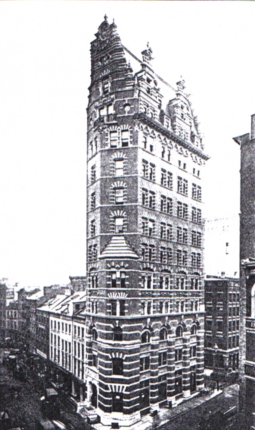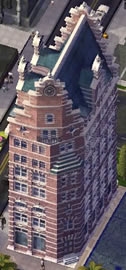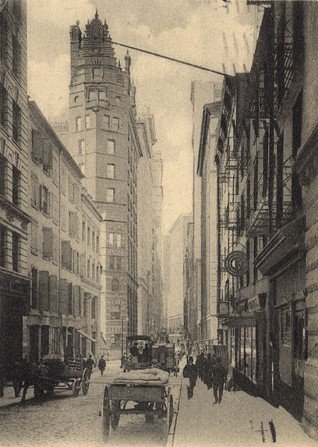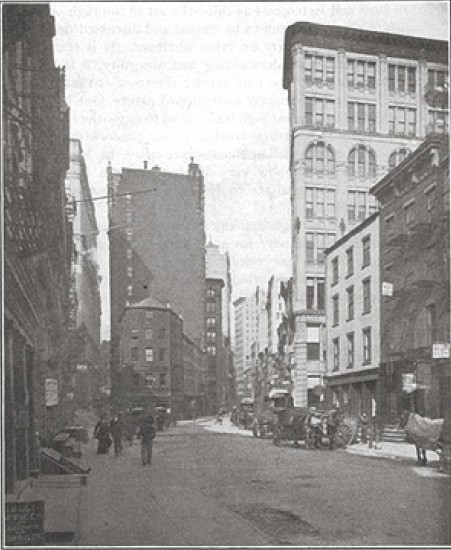|
The 13-story John Wolfe Building, built in 1895 on the
east side of William Street from Maiden Lane to Liberty Street. This
narrow and stepped building in the Flemish style, considered to be an
innovative way to solve various problems of the early skyscraper, was
demolished in 1974 for an ill-conceived street widening plan. The site
is now part of a glorified traffic island called Louise Nevelson Plaza.

Mighty Buildings That Were No Match for Automobiles
The Wolfe Building at Maiden Lane at William Street, as it looked in
1897. Like the insurance building, it was demolished in the 1970s.
Q. We recently redesigned the Louise Nevelson Plaza at the intersection
of Maiden Lane and Liberty and William Streets. What happened to the
buildings that were there before the plaza was created? ... Henry
Smith-Miller, Smith-Miller & Hawkinson Architects, Manhattan
A. What happened? Well, as my doctor sometimes says, this may hurt just
a little bit. There were two magnificent structures there, the
fantastical Wolfe Building of 1896, by Henry Hardenbergh, along William
Street, and the triangular German-American Insurance Company Building of
1907, by Hill & Stout, at the narrow end of the block.
The Wolfe Building was put up by the estate of John Wolfe, one of the
great hardware merchants of New York. The architect, Henry J.
Hardenbergh, was often trusted by estates and family building
operations, like that of the Rhinelanders.
Hardenbergh’s 12-story building was a tour de force of early skyscraper
design, in rich red brick trimmed with light-colored stone and terra
cotta in patterns of the Flemish and Dutch Renaissance.
Tall building design was an emerging and controversial field, and in
1896 the critic Montgomery Schuyler said Hardenbergh’s design proved
that the skyscraper was “artistically tractable.” He praised the skyline
of the Wolfe Building, particularly the angled facade on Maiden Lane,
which gradually diminished, through complicated angles and recessions,
into a spectacular gable perhaps 200 feet above the street.
The Wolfe Building was soon hard to see, hemmed in by other structures,
but the insurance building went up at the pointy end of the block, its
angled bow giving it a shiplike presence, slicing through the chop of
the older buildings. Frederick Hill, the architect, discussed it in the
journal Architecture in 1908, noting “the omission of any form of
cornice and the use of penetrated vaulting in its place,” referring to
the polychrome terra-cotta elements at the top.
Hill remarked that with the new crop of high buildings, the idea of
making a traditional cornice, with intricate architectural patterns,
“appears to us entirely wrong” and indeed “part of the problem over
which we are all working.” Architects were rethinking almost every
element of design as buildings got higher and higher. The new “A.I.A.
Guide to New York City,” by Norval White, Elliot Willensky and Fran
Leadon, calls the insurance building “magnificently corniced,
wonderfully proportioned.”
Both were demolished in the mid-1970s by Our Fair City to widen the
streets and improve traffic flow to the new World Trade Center. Kent
Barwick and Brendan Gill, both of the Municipal Art Society, protested,
Mr. Barwick calling demolition “needless” in The New York Times in 1974.
Although obvious candidates for landmark designation today, at the time
such second-tier commercial buildings were considered interesting but
not designation-worthy. Thus traffic won out, and the leftover land has
for years been a favorite lunch spot, Louise Nevelson Plaza. The plaza
does open up the view to the palazzolike 1924 Federal Reserve Bank, at
the William Street end of the block, although that is scant consolation.
Links
http://www.startsandfits.com/hardenbergh/index.html

The garish Freytag Building in the Sim City video game is a shortened
version of Henry J. Hardenbergh's 12-story John Wolfe Building, a
Flemish-styled historic New York City gem demolished in the 1970s.
Considering how striking it often looks in game, perhaps the taller
version would have been too conspicuous.
|


